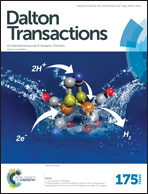Extraction of Nb(v) by quaternary ammonium-based solvents: toward organic hexaniobate systems†
Abstract
Solvent extraction of Nb(V) from alkaline aqueous media using quaternary ammonium solutions, especially Aliquat® 336 diluted in an aliphatic diluent, was investigated. The hexaniobate ions (HxNb6O19x−8) were extracted into the organic phase with very high yields at room temperature and within a few minutes, affording easy access to organic solutions of hexaniobates. Several parameters were found to influence the extraction of HxNb6O19x−8 including the nature and concentration of alkali cations, confirming subtle effects previously described for polyoxoniobates such as ion-pairing with alkali ions. The extraction of HxNb6O19x−8 with Aliquat® 336 is also influenced if competing anions are present in the aqueous phase (NO3−, Cl−, C2O42−, SO42− and CO32−) and varies with the pH mainly due to the competitive extraction of hydroxide ions at high pH. The co-extraction of sodium ions with HxNb6O19x−8 was observed as well as the co-extraction of water molecules, suggesting a self-association of the extractant. The proposed liquid–liquid extraction generic system paves the way for innovative niobium (and potentially tantalum) hydrometallurgical processes and it may also afford more direct routes for exploring the chemistry of hexaniobates in organic solvents.



 Please wait while we load your content...
Please wait while we load your content...